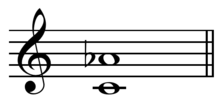- Minor sixth
-
minor sixth Inverse major third Name Other names Abbreviation m6 Size Semitones 8 Interval class 4 Just interval 8:5 or 11:7 Cents Equal temperament 800 24 equal temperament 800 Just intonation 814 or 782 In classical music from Western culture, a sixth is a musical interval encompassing six staff positions (see Interval (music)#Number for more details), and the minor sixth is one of two commonly occurring sixths. The minor quality specification identifies it as being the smallest of the two: the minor sixth spans eight semitones, the major sixth nine. For example, the interval from A to F is a minor sixth, as the note F lies eight semitones above A, and there are six staff positions from A to F. Diminished and augmented sixths span the same number of staff positions, but consist of a different number of semitones (seven and ten).
In equal temperament, the minor sixth is enharmonically equivalent to the augmented fifth. Its most common occurrence is between the third and (upper) root of major chords.
A minor sixth in just intonation most often corresponds to a pitch ratio of 8:5 or 1.6:1 (
 play (help·info)) of 814 cents;[1][2][3] in 12-tone equal temperament, a minor sixth is equal to eight semitones, a ratio of 22/3:1 (about 1.587), or 800 cents, 13.7 cents smaller. The ratios of both major and minor sixths are corresponding numbers of the Fibonacci sequence, 5 and 8 for a minor sixth and 3 and 5 for a major.
play (help·info)) of 814 cents;[1][2][3] in 12-tone equal temperament, a minor sixth is equal to eight semitones, a ratio of 22/3:1 (about 1.587), or 800 cents, 13.7 cents smaller. The ratios of both major and minor sixths are corresponding numbers of the Fibonacci sequence, 5 and 8 for a minor sixth and 3 and 5 for a major.The 11:7 undecimal minor sixth is 782.49 cents.[4] (
 Play (help·info)). In Pythagorean tuning, the minor sixth is the ratio 128:81, or 792.18 cents.[5]
Play (help·info)). In Pythagorean tuning, the minor sixth is the ratio 128:81, or 792.18 cents.[5]See also the subminor sixth, which includes ratios such as 14:9 and 63:40.[6] of 764.9 cents[7][8] or 786.4 cents,
The minor sixth is one of consonances of common practice music, along with the unison, octave, perfect fifth, major and minor thirds, major sixth and (sometimes) the perfect fourth. In the common practice period, sixths were considered interesting and dynamic consonances along with their inverses the thirds, but in medieval times they were considered dissonances unusable in a stable final sonority; however in that period they were tuned very flat, to the Pythagorean minor sixth of 128/81. In just intonation, the minor sixth is classed as a consonance of the 5-limit.
Any note will only appear in major scales from any of its minor sixth major scale notes (for example, C is the minor sixth note from E and E will only appear in C, D, E, F, G, A and B major scales).
subminor sixth Inverse supermajor third Name Other names Abbreviation m6 Size Semitones 8 Interval class 4 Just interval 14:9[9] or 63:40 Cents Equal temperament 800 24 equal temperament 750 Just intonation 765 or 786 Subminor sixth
In music, a subminor sixth or septimal sixth is an interval that is noticeably narrower than a minor sixth but noticeably wider than a diminished sixth.
The sub-minor sixth is an interval of a 14:9 ratio[10][11] or alternately 11:7.[12]
See also
Sources
- ^ Hermann von Helmholtz and Alexander John Ellis (1912). On the Sensations of Tone as a Physiological Basis for the Theory of Music, p.456.
- ^ Partch, Harry (1979). Genesis of a Music, p.68. ISBN 030680106X.
- ^ Benson, David J. (2006). Music: A Mathematical Offering, p.370. ISBN 0521853877.
- ^ International Institute for Advanced Studies in Systems Research and Cybernetics (2003). Systems Research in the Arts: Music, Environmental Design, and the Choreography of Space, Volume 5, p.18. ISBN 1894613325. "The proportion 11:7, obtained by isolating one 35° angle from its complement within the 90° quadrant, similarly corresponds to an undecimal minor sixth (782.5 cents)."
- ^ Benson (2006), p.163.
- ^ Jan Haluska (2003). The Mathematical Theory of Tone Systems, p.xxiii. ISBN 0824747143.
- ^ Duckworth & Fleming (1996). Sound and Light: La Monte Young & Marian Zazeela, p.167. ISBN 0838753469.
- ^ Hewitt, Michael (2000). The Tonal Phoenix, p.137. ISBN 3922626963.
- ^ Haluska, Jan (2003). The Mathematical Theory of Tone Systems, p.xxiii. ISBN 0824747143. Septimal minor sixth.
- ^ Royal Society (Great Britain) (1880, digitized Feb 26, 2008). Proceedings of the Royal Society of London, Volume 30, p.531. Harvard University.
- ^ Society of Arts (Great Britain) (1877, digitized Nov 19, 2009). Journal of the Society of Arts, Volume 25, p.670. The Society.
- ^ Andrew Horner, Lydia Ayres (2002). Cooking with Csound: Woodwind and Brass Recipes, p.131. ISBN 0895795078.
Intervals (list) Numbers in brackets are the number of semitones in the interval.
Fractional semitones are approximate.Twelve-semitone
(Western)PerfectMajorMinorAugmentedDiminishedCompoundOther systems SupermajorNeutralSubminor7-limitchromatic semitone (⅔) · diatonic semitone (1⅙) · whole tone (2⅓) · subminor third (2⅔) · supermajor third (4⅓) · harmonic (subminor) seventh (9⅔)Other intervals GroupsPythagorean comma · Pythagorean apotome · Pythagorean limma · Diesis · Septimal diesis · Septimal comma · Syntonic comma · Schisma · Diaschisma · Major limma · Ragisma · Breedsma · Kleisma · Septimal kleisma · Septimal semicomma · Orwell comma · Semicomma · Septimal sixth-tone · Septimal quarter tone · Septimal third-tone
MeasurementOthersCategories:- Intervals
Wikimedia Foundation. 2010.


